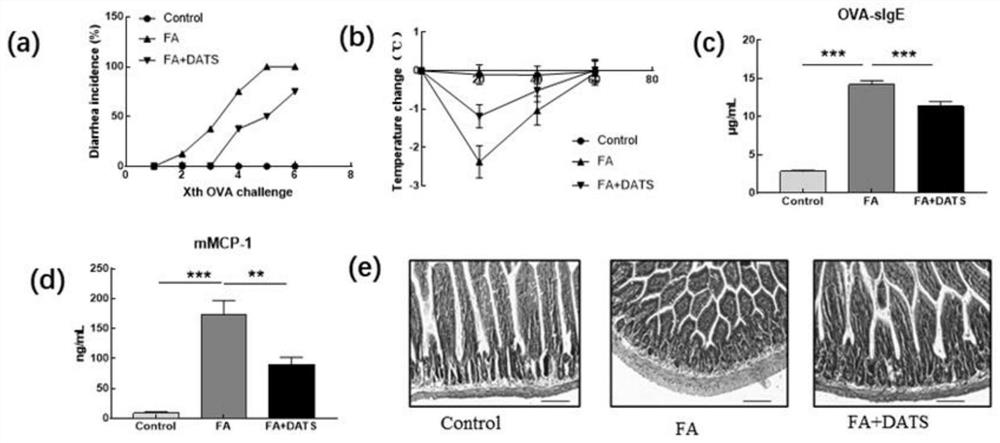Application of diallyl trisulfide to food allergies
A diallyl trisulfide, food allergy technology, applied in the field of medicine, can solve the problems of unresearched and clear food allergy pathogenesis and treatment methods, numerous allergens, complex pathogenic causes, etc., and achieves reduction of specific IgE levels and Mast cell protease levels, alleviation of the decrease in rectal temperature, and reduction in the incidence of diarrhea
- Summary
- Abstract
- Description
- Claims
- Application Information
AI Technical Summary
Problems solved by technology
Method used
Image
Examples
Embodiment 1
[0035] The establishment of embodiment 1 food allergy model
[0036] All animal experiments were approved by the Animal Ethics Committee of Jiangnan University, and carried out in accordance with national and international animal experiment ethics principles. Female Balb / c mice aged about 5 weeks were randomly divided into normal control group (Control), food allergy group (FA) and DATS group (FA+DATS). There are 6-8 rats in each group, and the feeding conditions are provided by Jiangnan University. The experimental group injected 50 μg of ovalbumin and 1 mg of aluminum hydroxide adjuvant into mice intraperitoneally on the 0th day and the 14th day of the experiment respectively. From the 28th day, 50 mg ovalbumin (Ovalbumin, Ovalbumin, OVA) challenge, 6 consecutive times, the control group was given an equal volume of normal saline. The FA+DATS group was orally administered 10 mg / kg DATS solution every day.
[0037] Within 1 hour of the last 50 mg OVA oral gavage, the recta...
Embodiment 2
[0038] Example 2 DATS relieves food allergy symptoms caused by OVA
[0039] Symptoms characteristic of IgE-mediated experimental food allergy, including anaphylactic diarrhea, decreased rectal temperature, serum levels of OVA-specific IgE and mast cell protease 1 in mice. The establishment method of the animal model is the same as in Example 1, and the severity of food allergy symptoms is analyzed by analyzing the changes of diarrhea and body temperature during the challenge stage of oral gavage. Rats showed a reduced incidence of diarrhea and a smaller decrease in body temperature as figure 1 As shown in (a), the diarrhea rate of mice supplemented with DATS decreased by 25%, and the body temperature change range was reduced to 1.2°C compared with 2.4°C in the model group.
[0040] The levels of OVA-specific IgE and mouse mast cell protease 1 in serum are also indicators of food allergy. Ovalbumin-induced food allergy depends on the production of IgE, thereby activating downs...
Embodiment 3
[0043] Example 3 DATS relieves Th2 cytokine release caused by OVA
[0044] When food allergy occurs, the levels of Th2 cytokines IL-4, IL-5 and IL-13 will increase significantly, and quantitative reverse transcription polymerase chain reaction is used to analyze IL-4, IL-5 and IL-13 in jejunum tissue The mRNA level was detected, and the total RNA was extracted using the TRIzol method according to the instructions. The jejunal tissue samples were first crushed in a high-throughput tissue grinder, and then extracted with chloroform. After centrifugation, the supernatant was aspirated, and an equal volume of isopropanol was added to precipitate RNA. After centrifugation, the supernatant was discarded and washed with 75% ethanol. After two times, dissolve in DEPC water. Reverse transcription was performed using Super Script II reverse transcriptase.
[0045] Use SYBR Green Supermix dye and specific primers (synthesized by Sangon Bioengineering (Shanghai) Co., Ltd.) for PCR analy...
PUM
 Login to View More
Login to View More Abstract
Description
Claims
Application Information
 Login to View More
Login to View More - R&D
- Intellectual Property
- Life Sciences
- Materials
- Tech Scout
- Unparalleled Data Quality
- Higher Quality Content
- 60% Fewer Hallucinations
Browse by: Latest US Patents, China's latest patents, Technical Efficacy Thesaurus, Application Domain, Technology Topic, Popular Technical Reports.
© 2025 PatSnap. All rights reserved.Legal|Privacy policy|Modern Slavery Act Transparency Statement|Sitemap|About US| Contact US: help@patsnap.com



